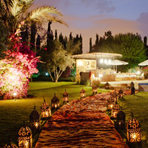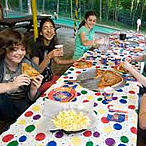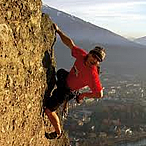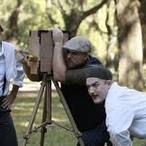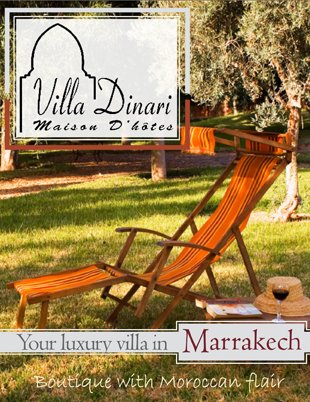A this time of year the scent of Fez is the scent of orange blossom, writes Derek Workman.

Today was hot, with crystal air and bright blue sky; one of the best days Fez has seen for a while. A week or so ago the air began to fill with the scent of zhar; the heady aroma of orange blossom. Young boys, and occasionally their sisters and mothers, take to the streets with poles to belt the orange trees and shake loose their snow fall of dainty white blossom.
Gathered in baskets, it is taken to the vendors in the Medina, and for the next couple of weeks the air will be rich with the pungent bouquet, as housewives swoop down to buy the basic ingredient of a scent and flavouring that permeates Moroccan culture. Taste a Moroccan pastry, and there is a fair chance that a dribble of orange blossom water has been added to the mix; visit a hammam, and the rich soaps and ungents might release a light perfume of orange; go to a celebration, particularly a wedding, and you will have your hands sprinkled with the water as a sign of welcome and good luck.
 photo credit Sandy McCutcheon
photo credit Sandy McCutcheon
Orange blossom water is big commercial business, but many households still prepare their own – and it’s a family affair. I’ve been invited to the Medina home of Michelle Reeves, where her mother-in-law, Mama Fatima Abdelmoula, is preparing the delicate brew, as she has done every year for the last forty-three years, since a neighbour taught her as a girl of fourteen.
We exchange salaams as I’m introduced to Mama Fatima, Fatima Chafik, Michelle’s girl Friday, and Khadija, Michelle’s daughter. Introductions aside, coffee, and mint tea are prepared, and a plate of wonderful pastries is produced, bought from a local bakery. Parts of a copper still, a katara, are waiting to be assembled, but there is the process of mixing the orange blossom to be gone through first. I take a bite of a brioche, a mouthful of coffee, and watch.
Michelle bought the blossom four days earlier, and it has been wrapped in layers of cotton since then, drying enough to remove excess moisture, but not enough to deplete the aromatic essence. I’m staying at a riad with an orange tree in the centre of the patio, and when I wake up each morning the scent drifts into my room. The morning is said to be the best time to buy the blossom, before the heat of the day has had a chance to drain the heady perfume away. I pick a small flower, and when I crush it between my palms the scent isn’t as intense as I expect it to be, so it seems that the blossom has to mature to the point of falling from the trees before it has enough essence for the distillation process to work.

A large copper still for orange blossom or rose distilling
The first step is to check the burner, heated from a gas bottle and hired along with the katara, the still. Rachida, nanny to Khadija and her baby sister Olivia, waves a cigarette lighter around the connection, and a small flame flares out from the connection of the plastic orange tube to the burner. The gas bottle supplier is sent for, appearing within a few minutes, and yes, he definitely agrees that it’s best not to continue until the escape is sorted out. From the bulbous pockets of his jacket he pulls out a spanner and undoes the connector, trims the end of the orange tube, and then finds that the screw clip that tightens tube to burner is broken and won’t tighten, hence the gas escape, and a new one of the correct size is the last thing he thought to bring. Could Fatima please nip down to his shop and get another one? She’s back in a couple of minutes, new connection made, and all is working wonderfully, and, as the kettle has just been boiled and the mint tea is ready to be poured he is invited to stay. The polite dialogue of, “I have to go,” “But you must have a glass of tea and a bun,” “Oh, alright then, if you insist,” is gone through and he is served a glass of mint tea and a splendid pastry dribbled in chocolate.
Mama Fatima begins the mix. Two kilos of orange blossom will provide about five litres of perfumed water. The still is in three parts; the bottom one contains the water for the distillation, the second one the mix, and the third one is a container of cold water which has to be continually changed to create the steam that is part of the distillation process.
 Orange blossoms on sale in the Saghra souk
Orange blossoms on sale in the Saghra souk
A thick layer of blossom is laid in the middle section of the katara, on top of it is placed an orange, which is then covered over with more blossom. The bottom section is filled with water, a few big handfuls of blossom, a couple of oranges and the peel of a lemon. This increases the intensity of the perfume as the liquid passes through the distillation process.
When Michelle told me about gathering the orange blossom I was confused. If they remove the blossom, how does the fruit grow? (I remember being told by an orange grower in Spain that the orange is the only tree that can bear blossom and fruit at the same time.) Apparently, the tree bears little fruit anyway, and you would be very unwise to eat it. It’s a bitter fruit, commonly known as a Seville orange, (wonderful in marmalade), and even though it has been the main tree found in Arab gardens for millennia, it was only ever used to provide decoration and flavourings for food and cosmetics. It is only marginally less tear-making than sucking on a lemon.
I’m chewing my second bun when the water container is put on the burner, the middle section with the majority of the blossom set in the tight- fitting flange of the base, and the cold water section placed on top. Mama Fatima asks for salt, and takes a handful from the container Fatima two hands her. “Part of the recipe,” I think, and then realise I’ve jumped the gun a bit as she scatters it in a circle around the base of the burner. “To keep Satan away,” she explains with a grin.
Fatima junior brings in two plastic kitchen bowls, which seem slightly out of keeping with the burnished copper of the still and abolishing the devil. In one is a murky, glutinous liquid and in the other are a pile of grubby strips of cloth. The sludge is argile, a green clay from the Middle Atlas Mountains, and known for its rejuvenation properties, which is why it is used in face packs. On this occasion it is being spread on the cloth strips before being wound around the joints of the three sections of the katara, and when it dries it will form a seal to stop the steam escaping. It seems that it is an excellent glue for the purpose, which sets me to think that when used as a face pack and sets, removing it quite literally peals away the years.
The tank begins to boil and Mama Fatima patches the odd seam in the cloths to prevent the luxurious essence escaping. The room begins to hint of the aroma of oranges. Mama and gas bottle man agree that all the seals are working to perfection, gas and steam, so he leaves. Surprisingly quickly, a fine stream of liquid begins to appear from the spout on the top section, and Mama Fatima carefully positions a five litre plastic water bottle under the dribble. Marginally quicker that watching paint dry, I see the bottle slowly filling with liquid as the perfume hangs thicker in the air. The plastic bottle begins to buckle and contract from the heat of the liquid, and Mama Fatima has to replace it with the smaller bottle that the orange blossom water will eventually be decanted into.
Every few minutes the top container has to be emptied, replacing the hot water with cold, to continue the distillation. You know when distillation is over because the perfume of oranges slowly fades. The bottles are filled and left for forty days to mature. I’d hoped to take a bottle back to England to celebrate the wedding of my son in three week’s time, but it looks as though I’ll have to buy a commercially produced bottle and cheat a little.
But they do say it’s the thought that counts.
I would like to thank Michelle Reeves of Plan-It Fez for her help with this article.
 Top fashion designer Meriyem Boussikouk from Casablanca (pictured left) has 20 years of experience in the industry. Yet she said she was still nervous about how the public would react to her new collection. “We have been nervous since we started preparing for the show, and our nerves grow as the event gets nearer, because we are not sure about ourselves 100 percent. There are new creations as well as new ideas we want to propose to the public, and we are not sure about the reaction (it’ll get). Will the public accept or reject what we offer?”
Top fashion designer Meriyem Boussikouk from Casablanca (pictured left) has 20 years of experience in the industry. Yet she said she was still nervous about how the public would react to her new collection. “We have been nervous since we started preparing for the show, and our nerves grow as the event gets nearer, because we are not sure about ourselves 100 percent. There are new creations as well as new ideas we want to propose to the public, and we are not sure about the reaction (it’ll get). Will the public accept or reject what we offer?”



























